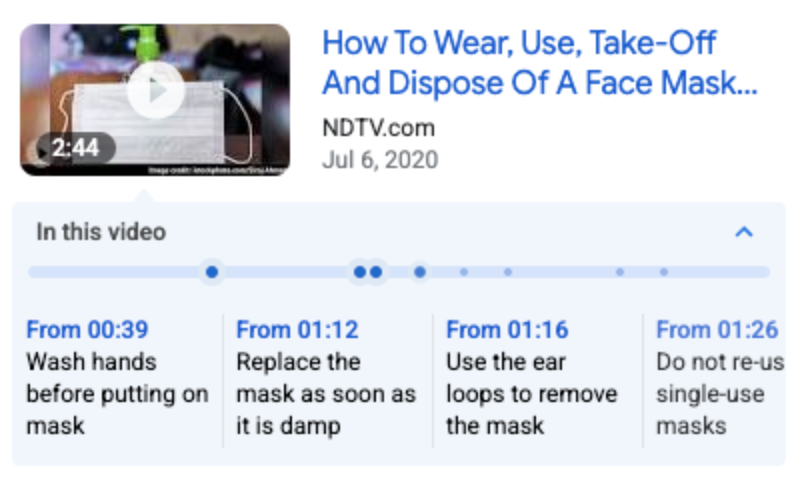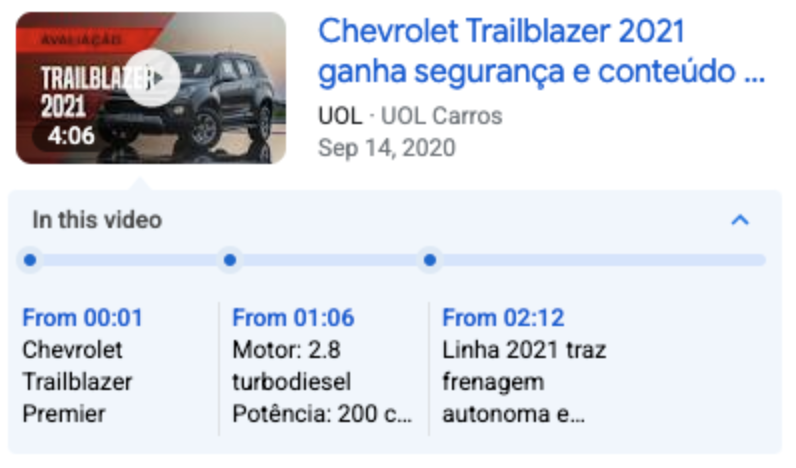الاثنين 19 تموز (يوليو) 2021
منذ أطلقنا ميزة المقاطع الرئيسية للفيديو في عام 2019، واصلنا العمل على تطوير هذه الميزة وتحسينها. وطوّرنا التصميم وأدخلنا المقاطع الرئيسية إلى المزيد من الفيديوهات، بما في ذلك على الأجهزة الجوّالة وأجهزة كمبيوتر سطح المكتب في جميع المناطق التي تتوفّر فيها خدمة "بحث Google". تساعد ميزة المقاطع الرئيسية المزيد من المستخدمين في الوصول مباشرةً إلى شرائح الفيديو الأكثر ملاءمة لهم، والتنقّل بينها مثل الفصول في الكتاب.
ونحن اليوم بصدد إطلاق آلية جديدة تتيح لك تفعيل ميزة "المقاطع الرئيسية" للفيديوهات على موقعك الإلكتروني، بدون بذل مجهود لتصنيف كل شريحة بشكل يدوي. ما عليك سوى إبلاغ Google بنمط عنوان URL للتخطّي إلى طابع زمني محدّد ضمن الفيديو. وبالتالي، ستستخدم Google تقنية "الذكاء الاصطناعي" لتحديد المقاطع الرئيسية في الفيديو وستعرض روابط تؤدّي مباشرةً إلى هذه المقاطع في نتائج البحث.


أعلنّا عن إطلاق الاستخدام التجريبي للترميز SeekToAction
للمرة الأولى أثناء مؤتمر Google I/O، واعتبارًا من اليوم، نعلن عن انتهاء الفترة التجريبية للميزة وتوفير
هذا الترميز لأي موقع إلكتروني يعرض فيديوهات. إليك بعض النصائح التي يجب أخذها في الاعتبار عند استخدام
هذا الترميز:
- يجب أن توفّر عناوين URL إمكانية إنشاء رابط لموضع معيّن في نقطة بخلاف نقطة البداية في الفيديو. على سبيل المثال، تسمح السمة
https://www.example.com/example?t=30بفتح الفيديو بعد مرور 30 ثانية من بدايته. - استخدِم الترميز
SeekToActionفي كل صفحة فيديو تريد من Google تحديد المقاطع الرئيسية فيها بشكل تلقائي واتّبِع إرشاداتنا الإضافية. إليك مثال مفصّل. - لتحديد المقاطع الرئيسية تلقائيًا في الفيديو، يجب أن يكون محرك البحث Google قادرًا على جلب ملفات محتوى الفيديو.
وتجدر الإشارة إلى أنّ الترميز SeekToAction لا ينطبق إلا على الفيديوهات المضمّنة في موقعك الإلكتروني. إذا
نشرت فيديوهات على منصّات عرض خارجية حيث لا تملك قدرة التحكّم في ترميز schema.org، يمكنك
التواصل مع منصّات العرض هذه لمعرفة ما إذا كان هذا الترميز متوفّرًا.
نأمل أن يوفّر الترميز SeekToAction طريقة أكثر سهولة وفعالية لتفعيل ميزة المقاطع
الرئيسية ومساعدة المستخدمين في التفاعل أكثر مع فيديوهاتك. إذا كانت لديك أي أسئلة، يمكنك نشرها في المنتدى،
أو التواصل مع @googlesearchc على Twitter، أو تقديم
الملاحظات مباشرةً على صفحات المستندات.
